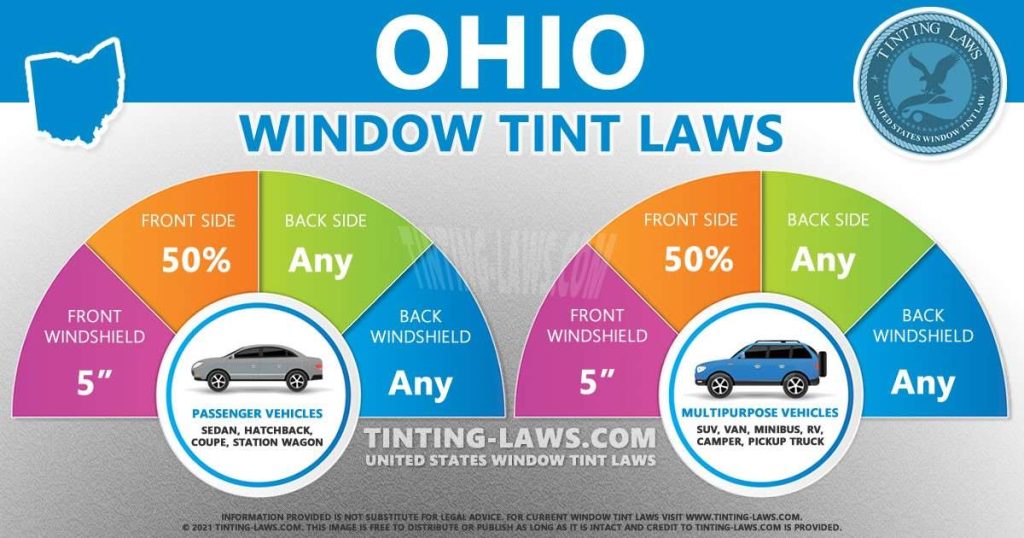Ohio Window Tinting Laws
Car window tinting laws in Ohio were enacted in 2004.
We have provided all the necessary information about your car’s window tint, including how dark or reflective the tint is allowed in your state.
There are also additional car window tinting rules and regulations in Ohio so make sure you read all about it below.
Window tint darkness in Ohio
The percent of visible light allowed through your car windows is called VLT: Visible Light Transmission.
The percentage of light allowed through your film and glass in Ohio is very specific and different for sedan cars and SUV cars or vans.
Tint darkness for sedans:
- Windshield: Non-reflective tint is allowed on the top 5 inches of the windshield.
- Front Side windows: Must allow more than 50% of light in.
- Back Side windows: Any darkness can be used.
- Rear Window: Any darkness can be used.
Tint darkness for SUV and vans:
- Windshield: Non-reflective tint is allowed on the top 5 inches of the windshield.
- Front Side windows: Must allow more than 50% of light in.
- Back Side windows: Any darkness can be used.
- Rear Window: Any darkness can be used.
Window tint reflection in Ohio
Window tint can reflect incoming light and reduce glare and heat.
Ohio window tint law permits a certain window reflection when using a tint so make sure you pay attention to this as well.
Tint reflection for sedans:
- Front Side windows: No reflectorized materials permitted.
- Back Side windows: No reflectorized materials permitted.
Tint reflection for SUV and vans:
- Front Side windows: No reflectorized materials permitted.
- Back Side windows: No reflectorized materials permitted.
Other Ohio window tint rules and regulations:
Ohio does have several other important laws, rules and regulations pertaining to window tinting. They include the following:
- Side Mirrors: No restrictions.
- Restricted Colors: No colors of tint are banned.
- Certificates: Manufacturers of film need to certify the film they sell in Ohio. Ask your dealer if they are using certified film.
- Stickers: The sticker to identify legal tinting is required between the film & glass on each tinted window.
- Medical Exceptions: Ohio laws make no mention of medical exemptions for special tint.
- Penalties: Misdemeanor with around $120 fine.
Keep in mind that Ohio tinting laws and regulations may be interpreted differently in your county or place of residence.
We always recommend double-checking our information with your local DMV or law enforcement authorities.

Our information about window tint laws in Ohio was last updated in 2024.
Tinting laws in Ohio were enacted in 2004.
In case any of our info provided is not up to date or correct be sure to contact us so we can fix it. Thanks!
Trusted industry leader in providing accurate window tint laws. Share with confidence:
State of Ohio Info
Ohio is a state in the Midwestern United States.
Ohio is the 34th largest (by area), the 7th most populous, and the 10th most densely populated of the 50 United States.
The state’s capital and largest city is Columbus.

Capital: Columbus
Population: 11,780,017
Area: 44,825 sq mi (116,096 km2)
Cities in Ohio: Cleveland, Cincinnati, Columbus, Steubenville, Akron, Dayton, Toledo, Youngstown, Canton, Defiance, Sandusky, Avon, Warren, Lima, Dublin, Put-in-Bay, Cuyahoga Falls, Strongsville, Xenia, Westerville, Findlay, Zanesville, Elyria, Mentor, Mansfield, Lakewood, Chillicothe, Springfield, Delphos, Wooster, Mason, Parma, Marysville, Kettering, Perrysburg, Shaker Heights, Grove City, Westlake, Columbiana, Athens, Yellow Springs, Massillon, Stow, West Chester Township, Hamilton, Loveland, Oberlin, Middletown, Chagrin Falls, Troy
Counties in Ohio: Adams, Allen, Ashland, Ashtabula, Athens, Auglaize, Belmont, Brown, Butler, Carroll, Champaign, Clark, Clermont, Clinton, Columbiana, Coshocton, Crawford, Cuyahoga, Darke, Defiance, Delaware, Erie, Fairfield, Fayette, Franklin, Fulton, Gallia, Geauga, Greene, Guernsey, Hamilton, Hancock, Hardin, Harrison, Henry, Highland, Hocking, Holmes, Huron, Jackson, Jefferson, Knox, Lake, Lawrence, Licking, Logan, Lorain, Lucas, Madison, Mahoning, Marion, Medina, Meigs, Mercer, Miami, Monroe, Montgomery, Morgan, Morrow, Muskingum, Noble, Ottawa, Paulding, Perry, Pickaway, Pike, Portage, Preble, Putnam, Richland, Ross, Sandusky, Scioto, Seneca, Shelby, Stark, State Level Sites, Summit, Trumbull, Tuscarawas, Union, Van Wert, Vinton, Warren, Washington, Wayne, Williams, Wood, Wyandot
Tint law references:
Ohio Revised Code Section 4513.241: Using tinted glass and other vision obscuring materials